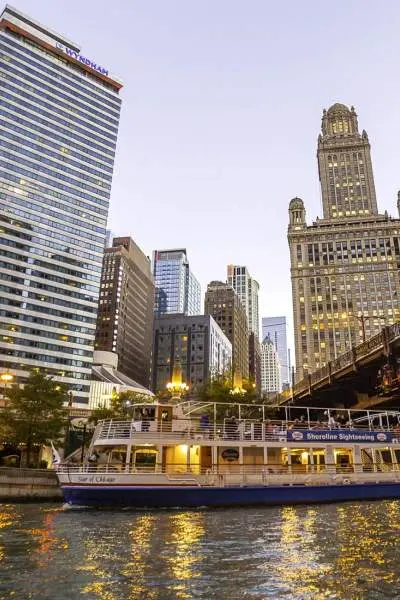
On virtually any street corner in Chicago, you’re surrounded by the inspiration of world-renowned architects playing out in brick, cement, glass and steel.
The city’s skyline reflects more than a century of architectural exploration sparked—in part—by the Great Fire of 1871, which decimated hundreds of old wood-frame and brick buildings squatting on the lakefront (one of the few surviving structures, the fortress-like Chicago Water Tower, now stands as an icon of North Michigan Avenue). In their place came a new generation of structures with steel skeletons perfected by the original Chicago School of architects—visionaries such as Louis Sullivan, Daniel Burnham, and Dankmar Adler.

After WWII, a second Chicago School pressed even higher. Bruce Graham and Fazlur Rahman Khan’s Sears Tower (now called the Willis Tower) topped the skyline as the world’s tallest building in 1973. Their John Hancock Center, as well as Edward Durell Stone’s Aon Center and Ludwig Mies van der Rohe’s Lake Shore Drive Apartments, added to the portfolio of downtown scene-stealers.
Today, the Windy City is known worldwide for its collection of towering skyscrapers. Visitors explore the city’s built environment with tours by foot, water, bike, bus, trolley or train. Stops include imposing, spare modernist towers reflected in the flat expanse of Lake Michigan and older, smaller buildings packed with history. New buildings on the drawing board or in construction promise exciting new explorations.

The Loop
In downtown Chicago, some buildings let you see for miles in every direction, while others let you peer directly into the past. The Chicago Cultural Center, for instance, looks all the way back to its 1897 opening as the Chicago Public Library, wowing visitors with a columned classical design of arched portals, multicolored marble and stained-glass domes topping symmetrical wings. Vaulting skyward, in contrast, is the 110-story Willis Tower, where visitors thrill to the views from The Ledge at Skydeck Chicago. Clear-glass cases jut out from the building’s 103rd floor. The 1930 Merchandise Mart building is vast enough that it once earned its own ZIP code. Originally comprised of warehouses and showrooms for Marshall Field and Company, the building shows off its Art Deco aesthetics with chamfer angles and a terrazzo-floor lobby with a 17-mural frieze. A recent $40 million renovation, including a food hall and technological improvements, has allowed the building to compete with its newer neighbors for prime showroom and office space.
5 More Treasures of the Loop
Fine Arts Building Galleries, artists’ lofts and recording studios find a home in this 11-story 1898 remodel with stately granite columns at the entrance and an Art Nouveau interior featuring century-old murals.
The National Intricate exterior etchings and motifs of lions and other creatures lend character to this 1907 Daniel Burnham building that’s been reimagined as a modern boutique hub of retail. Here’s where you’ll find the hot new Revival Food Hall, featuring 15 fast-casual stalls that showcase the finest of Chicago cuisine.
The Rookery Daniel Burnham drafted blueprints for the 1893 World’s Columbian Exposition (also known as the World’s Fair) in this building, which he also designed. In 1905,Frank Lloyd Wright remodeled the two-story lobby with gilded white carrara marble.
The Blackstone This luxe property has been dubbed The Hotel of Presidents for hosting 12 U.S. heads of state in its 118-year lifespan. A painstaking $128 million renovation in 2008 included the tuckpointing and refurbishing of 10,000 pieces of glazed white terra-cotta.
Chicago Athletic Association A boutique rehab at this historical men’s sports club added five bars and restaurants with cushy guest rooms above Michigan Avenue. Liven up an evening of revelry in the Game Room bar, where fair-themed bites accompany shuffleboard, chess, billiards and an indoor bocce court.
University of Chicago campus
Gothic architecture finds new and old forms on this wooded south-side Chicago school, with the ivy-covered Hull Gate and Joseph Bond Chapel well-suited for the grounds of European cathedrals. You’ll feel as if you’ve entered the Great Hall of Hogwarts while strolling through the William Rainey Harper Memorial Library, with its soaring arched ceiling and hulking chandelier. The more intimate Ida Noyes Hall charms visitors with intricately carved oak wainscoting and wrought-iron railings. Meanwhile, the blocky Henry Hinds Laboratory for Geophysical Sciences takes a modern twist on Gothic with an abundance of right angles. Additional campus marvels include the Rockefeller Memorial Chapel with its two massive pipe organs and the Joe and Rika Mansueto Library, containing a giant elliptical glass dome that covers the Grand Reading Room (its futuristic look help the building land a cameo in the film Divergent).
Oak Park
As downtown boomed, architect Frank Lloyd Wright found a way to make the horizontal take wing in his Prairie School homes, all accented by geometric details and custom furniture. Oak Park showcases some of the best examples of this style, including the master’s own Oak Park Home and Studio starring a two-story children’s playroom with vaulted ceilings and a skylight. Take a one-hour guided tour, or if you have a few hours, combine it with a self-guided audio tour of the exteriors of seven Wright-designed homes in town. The annual Wright Plus Housewalk in May includes rarely offered interior tours of homes and buildings designed by Wright and his contemporaries.

Interact with Architecture
The Chicago Architecture Foundation helms a variety of tours throughout the city. The popular River Cruise aboard Chicago’s First Lady departs from downtown Chicago’s Riverwalk. Guides give insights into more than 50 buildings while sharing fun facts about the city’s history on 90-minute boat tours. Dozens of walking tours are themed around niche interests such as Tiffany Treasures and Evolution of the Skyscraper. For an all-encompassing view of the city on a tight timeline, opt for the Must-See Chicago tour, which involves hopping on and off the famous L train to see landmarks, such as the Wrigley Building, the Art Institute of Chicago and the Chicago Theatre, all within a 90-minute time frame.
At 360 Chicago in the John Hancock Building, North America's fastest elevator whisks you to the 94th floor where you look out labeled window walls and use multimedia devices providing stories about the scenery. For an extra thrill with your views, get tickets for the TILT attraction, where a set of windows slowly leans forward over the Mag Mile.

Come back in the autumn to experience the Chicago Architecture Foundation’s popular Open House Chicago event, which allows free access to a changing menu of more than 200 architectural gems. Visitors will have exclusive access to skyscrapers, offices, private clubs, historic landmarks and some of Chicago’s most fascinating locales.
New Stars of the Skyline
Chicago is far from done with architectural trendsetting. One example: the sleek, ribbon-like 93-story Vista Tower, slated to be finished by 2020. Several other new structures have commanded attention over the past few years:
- A mixed-use tower called Aqua has drawn stares and selfies since 2009 for its wavy 82-story configuration.
- The 60-story Waldorf Astoria Chicago—with a Parisian-style exterior complete with spires and colonnades—opened in 2010.
- OneEleven, a geometrically segmented glass tower housing luxury apartments, opened in 2014.
- The lakefront’s Navy Pier got a makeover which included the new Centennial Wheel in 2016. Around 400 people can ride the 200-foot-tall wheel at a time. Gondolas feature interactive video screens loaded with Navy Pier information.
Share your Moments
#EnjoyIllinois




